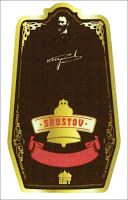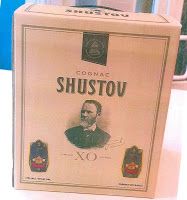Following an oral hearing on December 12, 2019, the Board denied a petition for cancellation of a registration for the mark SHUSTOV & Design (shown below) for various alcoholic beverages. Although petitioner GSH established a prima facie case of abandonment based on respondent's lack of use of the mark during the three-year period following registration, respondent successfully established its bona fide intent to commence use of the mark in commerce. GSH Trademarks Limited v. Sia"Baltmark Invest", Cancellation No. 92066594 (January 10, 2020) [not precedential] (Opinion by Judge George C. Pologeorgis).

Under Section 45 of the Lanham Act, a mark is deemed abandoned "When its use has been discontinued with intent not to resume such use. Intent not to resume may be inferred from circumstances. Nonuse for 3 consecutive years shall be prima facie evidence of abandonment." Because a trademark registration is presumed valid (Section 7(b)), the party seeking its cancellation must rebut this presumption by a preponderance of the evidence.
If plaintiff can show three consecutive years of nonuse, it has established a prima facie showing of abandonment, creating a rebuttable presumption that the registrant has abandoned the mark without intent to resume use. The burden of production (i.e., going forward) then shifts to the respondent to produce evidence that it has either used the mark or that it has intended to resume use (e.g., a convincing demonstration of "excusable non-use" that would negate any intent not to resume use of the mark). The burden of persuasion remains with the plaintiff to prove abandonment by a preponderance of the evidence.
Respondent's underlying application was filed under Section 66(a), and therefore it was not required to allege or declare use of its mark in commerce at the time of filing. However, once a registration issued from a Section 66(a) request for extension of protection, it is treated in the same way as any other registration (Section 69(b)), and the registrant must use the mark in commerce in order to avoid abandonment.
Here, the earliest date on which the three-year period could trigger the three-year statutory presumption of nonuse in this case was the registration date, i.e., March 24, 2014.
The Board found that petitioner had established a prima facie case of abandonment based on various Internet materials, including search results, that failed to show sales in commerce of respondent's goods under the subject mark during the three year period following issuance of the registration. Respondent did not provide any evidence that it did use the mark during that period.
In order to rebut petitioner's prima face case of abandonment, respondent was required to "produce evidence to establish its intent to begin use by showing 'special circumstances which excuse [its] nonuse.'" The Board noted that this is the same standard that is applied to determine whether a mark once in use has been abandoned.
To prove excusable nonuse, Respondent must produce evidence showing that, under its particular circumstances, its activities are those that a reasonable business, that had a bona fide intent to use the mark in United States commerce, would have undertaken.
Respondent's witness testified that within the three-year period, it entered into a license agreement with a New Jersey company to assist with the production, transport, importation, distribution, sales and marketing of the goods identified in the registration under the subject mark. In addition, respondent's importer filed a COLA labeling application, which was promptly approved.
Moreover, the evidence showed a continuing effort, after the three-year period, to commence use of the subject mark. A contract was entered for the sale of cognac. Shipping documents showed importation of product in November 2017. Another COLA labeling application was submitted in September 2017. The Board found that these actions "taken by Respondent and its agents within a relatively short time after the conclusion of the three-year statutory period of nonuse corroborate the existence of Respondent's intent to commence use of its registered mark during the three-year nonuse period."

The Board acknowledged that the COLA-approved labels did not display the subject mark, but the mark did appear on respondent's packaging (see above). Although respondent's testimony regarding a license agreement was not supported by the submission of the agreement itself, the Board found that that the testimony was clear and convincing and was not been contradicted by any other evidence.
Finally, petitioner argued that respondent showed only "token use" of the mark rather than any sustained effort to begin use. The Board disagreed as to the facts, and pointed out that "t[]he issue before us is not whether Respondent has made proper use of its mark in U.S. commerce but whether Respondent had a bona fide intent to commence use of its subject mark during the three-year nonuse period."
The Board found no basis "for finding that Respondent's activities were not those which would be taken by a reasonable business with a bona fide intent to commence use of a mark in U.S. commerce." And so it denied the petition for cancellation.
Read comments and post your comment here.
The content of this article is intended to provide a general guide to the subject matter. Specialist advice should be sought about your specific circumstances.

